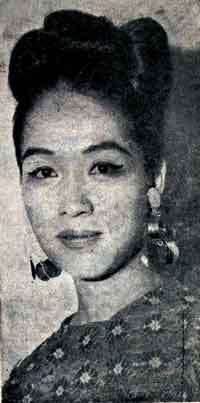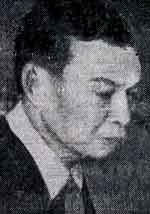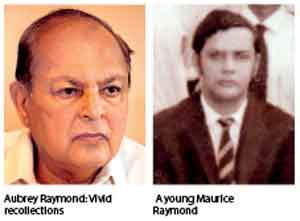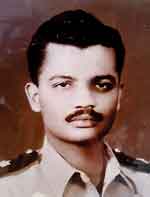Revisiting the Boonwaat case, 50 years on

The beautiful socialite Shirley Boonwaat (Times of Ceylon of October 16, 1967)
Did he get away with ‘blue’ murder? Was the ‘perfect’ murder carried out on Sri Lankan soil 50 years ago under the deep shroud of diplomatic immunity?
It was not in a remote and isolated jungle area but in the heart of Kollupitiya in Colombo, close to the Liberty Cinema, that on a lazy Sunday morning gunshots shattered the silence of the respectable neighbourhood hedged in by Turret Road (Dharmapala Mawatha) and Green Path.
The date was Sunday, October 15, 1967 and the ‘scene’ the residence of the Burmese (now Myanmar) Ambassador to Sri Lanka, W.K.H. Sao Boonwaat. It was ‘Carlton Lodge’, now home to Capri Club, where speculation still abounds of visions of a woman drifting by with anguished and heart-rending screams.
The tale of Boonwaat’s beautiful wife, Shirley, alleged killer-rage fuelled may be by anger and humiliation and many a life being devastated came to a close at least in Sri Lanka on October 24, when Ambassador Boonwaat left this land for good.
The events of the day were set off by a commotion, a woman attempting to flee, a car taking off in a hurry, gun-shots, two ‘eye’ witnesses, a death and a cremation. Then came a police probe by top brass with reports even being submitted to the then Prime Minister Dudley Senanayake, the hush-hush arrival of high-level Burmese officials, the alleged involvement of another diplomat’s son, claims for diplomatic immunity and Ambassador Boonwaat ‘recalled’ and whisked off to Rangoon.

Ambassador W.H. K. Boonwaat (The SUN of October 21, 1967)
Within a mere four to five hours, all traces of the beautiful socialite, erased without a trace, except a Register of Condolence kept the next day against “the backdrop of a coloured photograph of her illuminated by a subdued light from a candelabra with a solitary deep-red rose”, adding a touch of colour to the sombre atmosphere.
While many VIPs including representatives of the Defence Ministry filed into the ‘residence’ that had been the Boonwaats, signed the register and departed, 50 years hence we re-trace a paper trail to throw more light on this cloak-and-dagger incident to blow away the ashes and unearth something fresh. We also catch up with a few of those who played major roles in this tragic drama and are around to tell the tale.
There simply is no record of Madam Shirley Boonwaat being cremated on that fateful Sunday!
The burial and cremation register of the General Cemetery, Kanatte, Borella, with its meticulous records just does not have an entry of her cremation, even though some of the newspapers of the time, the Daily News, the Times of Ceylon and the SUN had captured a photograph of Shirley’s little children leaving the crematorium (the low building by the side of the tall new one) with a Burmese official.
 There are only 11 entries in the Kanatte register — two cremations and nine burials for October 15, 1967. Of the two cremations one was on a wood pyre and the other at the crematorium and both are of Sri Lankans, a man and a woman, with no mention of a foreigner! The person cremated at the crematorium on that day was the man.
There are only 11 entries in the Kanatte register — two cremations and nine burials for October 15, 1967. Of the two cremations one was on a wood pyre and the other at the crematorium and both are of Sri Lankans, a man and a woman, with no mention of a foreigner! The person cremated at the crematorium on that day was the man.
Within 10 short days in October 1967, meanwhile, everything linked to the Boonwaat incident which sent Colombo into shock had been wrapped up in this terrible thriller-like but sad sequence of events. It dominated the news of the day, in an era sans television and social media, with even the minutest detail being splashed on front pages, along with black-and-white images.
However, the mystery lingers with many loose ends as if there is a desperate plea from beyond death to tie them up.
Seated at the head of the long dining table in his home a stone’s throw from Kanatte, 80-year-old Aubrey Raymond, literally, turns back the pages of time.
Before him is a black book with a binding of red tape and pasted on a page somewhere in the middle section is a receipt – for the cremation of 35-year-old Mrs. Lao Boonwaat.
Vivid are the memories of Mr. Raymond of how the ‘Firm’ (A.F. Raymond, undertakers) got a phone call that morning around 10.

How leading newspapers of the day reported the Boonwaat case
Those were the days when there were only landlines and his brother, Maurice, six years his senior, answered the call of duty and took down the order. It was that a person had died at 62, Turret Road, Colombo 3. The instructions were specific – bring a coffin the size of 5’4”.
“When my brother went to the address immediately to check on the requirements, he was not allowed into the residence on the grounds that ‘it was Burmese territory’. He was asked to come again with the coffin, a middle-price range one, around 11.30 a.m. with instructions also to book the crematorium which he did at Rs. 15 as the fee charged by Kanatte,” says Mr. Raymond who was 29 years at that time. Brother Maurice lives in Sydney, Australia now, having migrated there in the early 1970s.
Dutifully, Maurice took the coffin, it was 5’6” just as a precaution, along with his staff. “My brother was allowed in and got a glimpse of a lady in a white costume, laid out on a bed,” says Mr. Raymond, explaining that soon after he too had to go out and people in the house manoeuvred the coffin in.
Just before 1 p.m., a sad little three-vehicle funeral procession wended its way to Kanatte – the hearse with the coffin, followed closely by a car with Burmese Buddhist monks and a second car with the family.
A day after the cremation, the police came knocking on the door of the Firm to ask for the ashes of Mrs. Boonwaat, most probably to check for bullet traces, says Mr. Raymond, adding that they had nothing to show as three hours after the cremation, Ambassador Boonwaat was at the crematorium to collect the ashes of his wife in a brass urn, while the Raymonds’ bill was settled not at the Turret Road residence but at the embassy down Rosmead Place.
“Maurice was quizzed by the police,” adds Mr. Raymond, while the newspapers reported that he had been asked by the police why the body had been cremated when the death certificate was for a burial. Maurice’s view had been that only a Coroner could order whether it should be a burial or a cremation. But in this case there had been no autopsy and no inquest, so the family could decide whatever they wished.

The black book and (right) the receipt of payment for Shirley’s funeral arrangements. Pix by M.A. Pushpa Kumara
While the coffin was being quietly taken out of the Green Path gate of the Burmese Residence, two high-level police officials were banging on the Turret Road gate which was locked and barred, with no sign even of a worker. At this gate was none other than the Officer-in-Charge (OIC) of the Kollupitiya Police Station, Inspector (IP) John Tennekoon and OIC Crimes IP Ignatius Canagaretnam.
An anonymous phone call to the operator at the Kollupitiya Police Station had tipped them off that all was not right at the residence of the Burmese Ambassador.
“The phone call, we believe, was from someone inside the residence itself, most probably a housemaid who was fond of Mrs. Boonwaat,” says Mr. Canagaretnam. As soon as the telephone operator brought the urgent message that there had been “a shooting” at the Ambassador’s residence, they feared that the envoy may have been targeted. He then ran into John’s room and together they jumped into John’s car, a Ford, and rushed to the Turret Road gate. Both of them knew the Boonwaats well, he says, as whenever there was a function at the residence, Shirley would invite them as well.
Mr. Boonwaat was over 50, he recalls, while Shirley was much younger. When they arrived at No. 62, they parked the car near the entrance and banged on the gate but to no avail. For an ambassadorial residence which would have a large staff, not a soul even peeked out. What they did not realize was that there had been some activity at the Green Path gate, from which the funeral procession had left surreptitiously. It was then that John called Police Headquarters only to be told that they could not enter the ambassadorial premises “unless invited” as it was Burmese property.

Then: Ignatius Canagaretnam
The police duo waited and waited, “with no lunch” outside the house and when the Burmese returned from Kanatte was told that “the Ambassador doesn’t wish to see them”, says Mr.Canagaretnam.
Opposite the Boonwaat residence was a construction site and it was the workers there who said “api dekka” (we saw) and from whom they got an account of the happenings………a woman running out of the residence through the porch and then being dragged back in by two men and shots being fired, with Mr. Canagaretnam stating that Ambassador Boonwaat had a son (stepson to Shirley) who was a youth of about 21 from his first marriage, with suspicions that one of the men who dragged her back in was him.
The rest we gather from the newspapers of the day with reports having just two bylines, Peter van Reyk of the Daily News and Nihal Jayasuriya of the SUN. The reports covered how Mrs. Boonwaat well-known in local religious and social circles had been in “gay spirits” at a private dinner party the night before her death; of police recording the statements of bricklayers G. Wimalasena (18) and K.C. Wilbert (22) and also a servant in an adjoining house that they saw a woman running to get into a car in the Ambassador’s house and a man firing two shots and the woman’s pace slackening, the man in the car driving away, the woman being taken into the house and the doors being shut, screams from within the house and shots and finally dead silence.
Another news report stated: “The police have learnt that a Ceylonese friend of Mrs. Boonwaat and another person who acted as his bodyguard, visited the Boonwaat residence on the morning of the incident. While the bodyguard stayed in the car — a cream coloured Volkswagen — Mrs. Boonwaat’s friend walked into her residence………when this person entered the house there was a heated argument going on above the stairwell of the house. The outsider was involved in the argument. It is alleged that a revolver was pulled out and fired. The shot missed the Ceylonese and he ran out followed by Mrs. Boonwaat, who was apparently trying to shield him. While the Ceylonese friend and his bodyguard drove away in the Volkswagen, Mrs. Boonwaat was carried into the residence where three more shots are reported to have been fired. According to some informants, Mr. Boonwaat was not at the scene.”
Another version that did the rounds was that Mrs. Boonwaat collapsed on the steep staircase of her residence and that when medical assistance arrived she was lying at that point, already dead, with a doctor giving the cause of death as “cerebral haemorrhage” due to hypertension, after which the Medical Registrar on Union Place, Dr. Rutnam had issued a ‘burial certificate’.
Controversy had erupted over how the cause of death could have been determined without an autopsy.
Other news reports stated that Rex de Silva made a statement that he first came to know Madame Boonwaat about three years before at the ‘Blue Leopard’, they had been friends since then, how she had complained of harassment and ill-treatment, that he stayed at the ambassadorial residence for about a year, how on one occasion he took her to a nursing home due to an injury, how there was an incident when a bullet was fired harmlessly and how he left the residence after that and how a few days later he was assaulted early morning by certain persons.
More reports indicated that at around 12.15 p.m. on October 15 a phone call “purporting” to be from the Burmese Embassy was made to the Defence and External Affairs Ministry to advise the ministry of the death and intended cremation of Madam Boonwaat, how when the ministry rang back to ascertain the time of the cremation, there was no answer, how a ministry official drove to the Boonwaat residence where a manservant directed him to Kanatte and by the time he arrived there, the cremation was already over.
Things happened quickly thereafter, with high-level discussions and Burma insisting on diplomatic immunity for its Ambassador sending in two top officials with the visit being kept under wraps, with these officials holding talks only with officials of the Defence and External Affairs Ministry and not the local police. Later they had visited the Boonwaat residence, attempting to “play hide-and-seek” with press photographers after which they had inspected the garden.
“What we heard later was that Boonwaat was tried and sentenced by a court in Rangoon. Whether it was a farce and whether he went to jail no one seems to know,” adds Mr. Canagaretnam on a final note.
For Sri Lanka, however, the case was closed.
| A glimpse of those times | |
| Starting with the paper-trail, we launched an effort to trace all those who had played a role in this tragic but real-life murder-drama of yesteryear. Friends of friends, contacts, phone calls, e-mails, social media, all were drawn in to get a glimpse of those times.It was the Swinging Sixties, with a vibrant nightlife and many who frequented night clubs such as the ‘Coconut Grove’ at the Galle Face Hotel and the ‘Blue Leopard’ at the Grand Oriental Hotel would wine, dine and dance the night away. Among the regulars, of course, were the stunning Shirley Boonwaat and the Band Leader of Rhythm Dukes, Rex de Silva who was also a pianist. Rex de Silva’s band played for two years, we learn, at the up-market and exclusive ‘Club 388’ down Union Place owned by Nimal Fonseka where champagne was the order of the night and the dress code was formal including black tie. The Rhythm Dukes comprised female vocalist Marie de Rosairo and male vocalist Ishan Bahar who also played guitar and Milroy Passé de Silva, Tom Menezes, brothers Valentine and Lucky Manikavasagar, Rodney Van Heer and Ralph de Zilva. Says Marie who knew the “lovely and wonderful” Shirley, “ She would come to the club, while we were practising and do a little sewing and during breaks I would chat to her.” It was common knowledge that Shirley was unhappy as it had been a child-marriage, says Marie. Memories of the Sunday of Shirley’s death are crystal clear……“Rex was devastated. When I went in to work, all were in shock. We could hardly perform that night,” she recalls. Looking back on those times, many who were in their late teens and early 20s, reminisce how a princely sum of two rupees could give a night of dancing and merriment at the Coconut Grove, with bands such as Eranga & Priyanga and the Jetliners keeping everyone’s toes-tapping. “A bottle of beer was Rs. 2.50 and a coke Rs. 1.50. Cars being a rarity, the bus-fare home was 20 cents.” Soon after Shirley Boonwaat’s death, the Rhythm Dukes disbanded, with Rex migrating to England. |
| Where are they now? | |
| Shirley Boonwaat is dead, with no insight on where her ashes are, while there is no information on Ambassador Boonwaat.Maurice Raymond who attended to the funeral arrangements lives in Sydney, Australia. Dr. L.C. Mendis who issued the cause of death as ‘cerebral haemorrhage’ is also believed to have migrated to England and is no more. There is no news of Dr. Rutnam who issued the burial certificate. Inspector General of Police Eleric Abeygoonawardene is no more Colombo’s Superintendent of Police Jack Van Sanden is dead Kollupitiya OIC Inspector John Tennekoon is dead Kollupitiya OIC (Crimes) Inspector Ignatius Canagaretnam who went onto become Deputy Inspector General of Police lives in retirement in Kotahena. Prime Minister Dudley Senanayake who was also Defence and External Affairs Minister is no more. Permanent Secretary, Defence and External Affairs, G.V.P. Samarasinghe is dead Director of Foreign Relations Ben Fonseka is dead Sri Lanka’s Ambassador to Burma at that time, Dr. N.D. Wijesekera is no more. |



